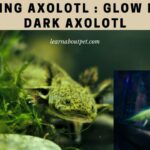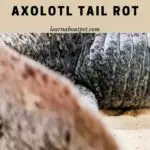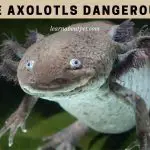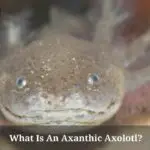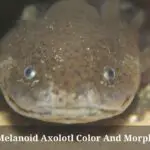The perceived value of axolotls (as pets) depends to some extent on their colors. Axolotls that come in the rarer colors tend to attract more attention than those that come in the more common colors. This in turn generates a lot of interest in people who want to know about the rarer axolotl color(s).
What is the rarest axolotl color in real life? The rarest axolotl color that is practically obtainable in real life is the firefly color. It is dark, like the wild type axolotl, but with a fluorescent green tail that glows in the dark. Other very rare but almost impossible to obtain axolotl colors include enigma, chimera and mosaic.
The piebald axolotl is another rare but practically obtainable axolotl color. It is basically white, but with symmetrical patches on both its face and back. Its gills are red, with its eyes being black.

How Many Colors Do Axolotls Come In?
Often, just before the question on what is the rarest axolotl color in real life comes this one – on how many colors axolotls come in.
As it turns out, thanks to breeding programs, the number of axolotl colors is always growing. Currently, there are at least 20 axolotl colors.
Which Are The Most Common Axolotl Colors?
Before going ahead to answer the question on what is the rarest axolotl color in real life, it is good for us to first have insight on what the common axolotl colors are.
So, which are the most common axolotl colors?
The most common axolotl colors (in real life) include leucistic – which is pinkish and wild type axolotl. The latter (wild type axie) is dark, with golden speckles. Other common colors are white albino, golden (which is bright yellow) and melanoid (which is very dark).
What Are The Rare Axolotl Colors?
Rare axolotl colors include copper and green.
Others are firefly color, mosaic, chimera, enigma and piebald.
Some are rarer than others. For instance – with some luck – you may find a firefly axolotl for sale. But it would be almost impossible to find a mosaic axolotl for sale.
But even for the more common axolotl colors, there are variations that may be a bit hard to find. For instance, the melanoid may be easy enough to find. But if you set out in search of heavily-marked melanoid axolotl, that may be more of a challenge.
What Is The Rarest Axolotl Color In Real Life?
Here, it is important to be clear that the question is on what is the rarest axolotl color in real life. That is as opposed to what is the rarest axolotl color in Minecraft? Or what is the second rarest axolotl color in Minecraft?
In Minecraft, there is no question about it: it is the blue axie that is the rarest.
But what is the rarest axolotl color in real life? One would argue that the rarest practically obtainable axolotl color in real life is the firefly color. It is dark, like the wild type axolotl. But it has a green tail that is fluorescent, and which therefore glows in light.

There are, of course, even harder to find axolotl colors, such as mosaic, enigma and chimera. But these are really not practically obtainable. They only come about as a result of ‘accidents’ in breeding programs.
For instance, two eggs have to fuse, for us to end up with a chimera or mosaic.
But if you are looking for the rarest axolotl color you can buy in real life (from a breeder), then firefly is the one.
If you want a brighter looking but very rare color, consider opting for piebald.
How Do Axolotls Get Their Color?
Axolotls get their colors from special cells called chromatophores. The ones available to any axolotl will depend on its genetic heritage. This is to say that, ultimately, axolotl colors depend on their genes.
Final Verdict – What Is The Rarest Axolotl Color In Real Life
The rarest axolotl color in real life (which is practically obtainable) is firefly color. This is a dark axolotl, but which has a green tail that glows in fluorescent light.

Other very rare but practically unobtainable axolotl colors include enigma, mosaic and chimera. The latter two – mosaic and chimera—only come into being when two eggs fuse accidentally in the course of breeding.
As a pet lover, make sure to learn about pet more and give your pet axolotl a good and comfortable life!

Welcome to Learn About Pet. My name is Rajkumar Ravichandran and I love all pets, travel, and amazing food. I write about my passion and personal experience caring for multiple pets in this blog! ❤️
Post Disclaimer
DISCLAIMER: THIS BLOG OR WEBSITE, "Learn About Pet", DOES NOT PROVIDE YOU WITH MEDICAL ADVICE AND IS NOT A SUBSTITUTE FOR MEDICAL ADVICE. ALWAYS GET IN TOUCH WITH YOUR PERSONAL VETERINARIAN AND USE INFORMATION HERE AS GENERAL ADVICE.
The information, including but not limited to, text, graphics, images and other material contained on this website are for informational purposes only. No material on this site is intended to be a substitute for professional veterinary advice, food recommendation, diagnosis, or treatment. Always seek the advice of your veterinarian or other qualified health care provider with any questions you may have regarding a medical condition or for pet food related questions.
